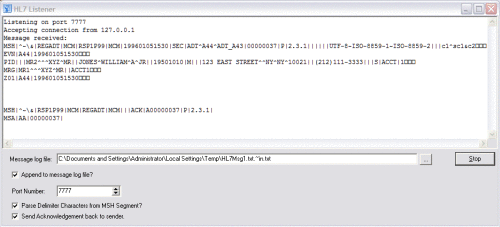 To Run a Sample Project
To Run a Sample Project
Before You Begin
Make sure the Connectivity Map you want to run is deployed.
-
Create a text file with the following content. Name the file HL7Msg1.txt (unless you modified the file name in the Connectivity Map properties).
MSH|^~\&|REGADT|MCM|RSP1P99|MCM|199601051530|SEC|ADT^A44^ADT_A43|00000037|P|2.3.1| |||||UTF-8~ISO-8859-1~ISO-8859-2|||c1^sc1&c2 EVN|A44|199601051530 PID|||MR2^^^XYZ^MR||JONES^WILLIAM^A^JR||19501010|M|||123 EAST STREET^^NY^NY10021| |(212)111-3333|||S|ACCT|1 MRG|MR1^^^XYZ^MR||ACCT1 Z01|A44|199601051530
-
Place the sample input file in the configured input directory for the File Adapter.
When the File Adapter picks up the file, it appends “.~in” to the filename.
-
Verify the output data from your output directory.
This sample contains messages that the recipient will accept as valid and properly formatted. The sample messages are used to design the interface.

HL7 Messages are ASCII messages (unlike protocols such as DICOM), and the standard requires that they be human readable.
- © 2010, Oracle Corporation and/or its affiliates
